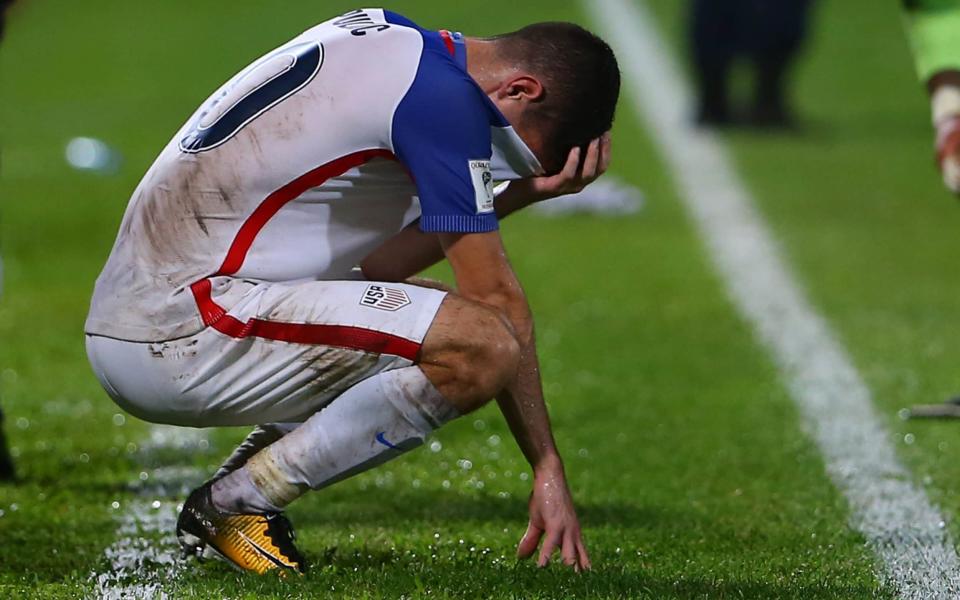U.S. Soccer needed a good shakeup; now it has half a decade to reflect and reform
On the morning after, it’s hard to peer through the dust and fog and see a clear picture of what’s ahead. Picking through the still-smoldering wreckage of the United States men’s national team’s failed qualification campaign for the 2018 World Cup following an unimaginable 2-1 loss in Trinidad and Tobago on Tuesday, there are many questions and hardly any answers.
But, remarkably, there is already broad consensus that a big shakeup in every section of the American game — on the men’s side, that is — is needed. This is acknowledged by all but the two people perhaps most responsible for the failure to reach Russia — head coach-for-now Bruce Arena and U.S. Soccer president-for-now Sunil Gulati.
Arena, whose long Hall of Fame resume now has an unsightly stain on it, and who was only signed through the World Cup, argued after the game that there was no need for wholesale changes on the basis of one result. And Gulati, who faces opponents for the first time ever in his bid for re-election in four months, called for a deliberate review process, rather than rash decisions. Of course, both have a vested interest in the survival of something closely resembling the status quo — either for legacy or continuity reasons.
And while the latter is a valid suggestion, and something that has served U.S. Soccer well in almost 12 mostly successful and always steady years under Gulati’s stewardship, it simultaneously feels like a misreading of the situation.

Because this is about much more than a single, pivotal loss with a generational fallout. The issues run much deeper than that. The senior national team has alternated between stasis and decline for years, a troubling trend masked by uncharacteristically solid performances at the last two World Cups. For all the investment, the results on the youth national teams are mostly headed downwards, not up. And the youth game is still a Wild West of opportunistic entrepreneurs, charlatans and monorail salesmen.
So now what?
First, it’ll be almost five years until the U.S. plays at another World Cup — at the soonest. This, in other words, presents an opportunity to rebuild the senior national team from the ground up with a core of players that could blossom a half decade from now.
This will mean saying goodbye to a slew of loyal servants to the program who might have been central to the efforts in 2018, but are unlikely to be key cogs four years thereafter. There is no reason at all now not to only field players in their early 20s or younger. Might they lack experience? Certainly, but they have almost five years to acquire it. Might results slip even further? Yes, but what’s left to lose? Laying an egg at the 2019 and 2021 Gold Cups? A small price to pay for the potential upside of empowering a promising young generation to thrive at future World Cups, surely.
Such a team will need a new coach with fresh and modern and clear ideas about how to get the best out of it — both on swampy CONCACAF fields with qualification on the line and when facing a European or African juggernaut in a World Cup round of 16. He’ll need strong coaching qualifications, which is to say he needs to have done actual coaching — rather than just overseen broad top-down policies, like Jurgen Klinsmann had before he took over the U.S. program.
The youth game should be the next thing in U.S. Soccer’s sights. It has been left unkempt and unregulated for far too long. What mechanisms are available for whipping it into shape is unclear. If they don’t exist, they must be invented. Because the quantity-over-quality, for-profit approach has been harmful for too many years.
Most competitive youth teams charge $3-5k/player JUST TO SHOW UP.
— Mike Foss (@themikefoss) October 11, 2017
An average — very average talent — is easily paying $10k/year for the privilege to stop playing in high school.
— Mike Foss (@themikefoss) October 11, 2017
In the same sort of way, the youth game will have to be nationalized. How do you un-privatize a thriving industry? You would have to somehow convince more of the Development Academy — than just the MLS academies and a few other scholarship-funded teams — to ditch five-figure participation fees, or even four-figure and high-three-figure ones. Then you’d need enormous expansion of regional U.S. Soccer-run training centers to skim the best talent off the top, the way most other thriving soccer nations have.
You’d have to come to some sort of arrangement with the NCAA to take the onerous shackles off the college games to re-make it as an alternative route for late-bloomers. And the whole thing would have to be incentivized by the end result, rather than profit off the process. That is to say, be paid out for players who rolled off the far end of the conveyor belt with market value and that money trickling back to those involved in development. That doesn’t happen now, as Major League Soccer refuses to honor the customary and FIFA-mandated solidarity payments to youth clubs when a fully-matured player is sold abroad.
Then the power structure at the United States Soccer Federation will probably need to be addressed, or at least reviewed. The nexus of its decision-making process has been the same for more than a decade. Gulati has been president since early 2006 and a key figure for much longer than that. Dan Flynn has been CEO and General Secretary since 2000. That’s a long time for two men to be calling the shots — on all manner of things, including coaching hires — more or less by themselves.
None of these moves would make all the difference on their own. But collectively, they could begin to shake loose some cobwebs and draw attention to problems that have gone without mending for so long that they’ve grown rusty. It’s worth at least exploring other ways of doing the same old things. The American men’s game is in a rut that long predates and supersedes a humid night in Trinidad and Tobago that will live in infamy.
Some of these mooted reforms will work; many of them won’t. But these aren’t solutions. They are a start to a harsh and overdue self-assessment.
Leander Schaerlaeckens is a Yahoo Sports soccer columnist and a sports communication lecturer at Marist College. Follow him on Twitter @LeanderAlphabet.



